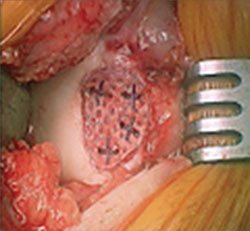Pilot study shows advantages of one-stage cartilage autografting over microfracture
OSLO — Improved functional results and better fill of treated focal cartilage defects were reported among patients randomized in a pilot study to treatment with a one-stage autologous cartilage repair technique vs. those who underwent microfracture.
K. Fredrik Almqvist, MD, PhD, of the University of Gent, in Gent, Belgium, an investigator for the multinational pilot study of the cartilage autograft implantation system (CAIS), which DePuy Mitek and Johnson & Johnson Regenerative Therapeutics LLC jointly developed, presented some short-term results from the European arm of the study at the 2010 ESSKA Congress, here.
The study compared results in 25 patients randomized 2:1 to CAIS or microfracture, a bone marrow stimulation technique, and observed them for 48 months.
 The cartilage autograft implantation system was used to treat a condyle defect. Image: Almqvist KF |
Cartilage autografting is a single-stage surgical procedure for harvesting and implanting a cartilage graft.
The European CAIS trials involved up to two symptomatic, contained, unipolar focal chondral cartilage defects per patient that were International Cartilage Repair Society grade I to IIIb or I to IVa for osteochondritis dissecans.
Mean changes in the Knee Injury and Osteoarthritis Outcome Score function/sports recreation subscale favored the CAIS group over the microfracture group at 12, 18 and 24 months postoperatively and results seen in goat and horse studies of the CAIS technique suggest good cell growth and viability, Almqvist said. – by Susan M. Rapp
Reference:
- Almqvist KF, Farr J, Cole B, et al. A single stage procedure for cell-based repair of symptomatic cartilage defects. 24 month results from a pilot study. Paper #FP14-512. Presented at the 2010 ESSKA Congress. June 9-12. Oslo.
- K. Fredrik Almqvist, MD, PhD, can be reached at De Pintelaan 185, 9000 Gent, Belgium; +32-9-40-2227; e-mail: fredrik.almqvist@ugent.be. He is a member of DePuy’s speaker’s bureau.
The results merit further exploration of a possible beneficial effect of CAIS and to better learn how it will fit in the scale of treatments available for different patients and indications. Two aspects are especially important: The one-step approach is attractive. If the quality of tissue regeneration is good and outcomes are similar or better than microfracture, that would prove useful. The second is the cost aspect because health care costs should be in balance with the quality life years they provide.
Currently, the cartilage repair field is producing good studies in bio-reconstructive patient care. The recognition of relevance of cartilage disease in patients is increasing among practitioners, yet payers are only starting to appreciate this clinical problem. Therein lies the challenge. Good scientific efforts, such as this and other recently published trials, are essential. One-step techniques and proper patient selection is, in my opinion, the way forward and represents a possible addition to our algorithm.
– Daniel B.F. Saris, MD, PhD
Utrecht, The
Netherlands
Vice President,
International Cartilage Repair Society
